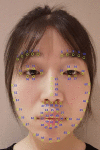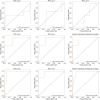Detection of hypomimia in patients with Parkinson's disease via smile videos
- PMID: 34532444
- PMCID: PMC8422154
- DOI: 10.21037/atm-21-3457
Detection of hypomimia in patients with Parkinson's disease via smile videos
Abstract
Background: Parkinson's disease (PD) is a neurodegenerative disease characterized by the impairment of facial expression, known as hypomimia. Hypomimia has serious impacts on patients' ability to communicate, and it is difficult to detect at early stages of the disease. Furthermore, due to bradykinesia or other reasons, it is inconvenient for PD patients to visit the hospital. Therefore, it is appealing to develop an auxiliary diagnostic method that remotely detects hypomimia.
Methods: We proposed an automatic detection system for Parkinson's hypomimia based on facial expressions (DSPH-FE). DSPH-FE provides a convenient remote service for those who potentially suffer from hypomimia and only requires patients to input their facial videos. Specifically, patients can detect hypomimia through two aspects: geometric features and texture features. Geometric features focus on visually representing structures of facial muscles. Facial expression factors (FEFs) are used as the first metric to quantify the current activation state of the facial muscles. Facial expression change factors (FECFs) are subsequently used as the second metric to calculate the moving trajectories of the activation states in the videos. Geometric features primarily concentrate on spatial information, with little involvement of temporal information. Thus, the extended histogram of oriented gradients (HOG) algorithm is introduced. This algorithm can extract texture features within multiple continuous frames and incorporate the temporal information into the features. Finally, these features are applied to four machine learning algorithms to model the relationship between these features and hypomimia.
Results: The DSPH-FE detection system achieved the best performance when concatenating geometric features and texture features, resulting in a F1 score of 0.9997. The best F1 scores achieved with geometric features and texture features were 0.8286 and 0.9446, respectively. This indicated that both geometric features and texture features have an ability to predict hypomimia, and demonstrated that temporal information can boost the model performance. Thus, DSPH-FE is an effective supportive tool in the medical management of PD patients.
Conclusions: Comprehensive experiments demonstrated that proposed features fit well with real-world videos and are beneficial in the clinical diagnosis of hypomimia. In particular, hypomimia had a greater impact on eyes and mouths when patients are smiling.
Keywords: Parkinson’s hypomimia (PD); detection system; facial expressions; geometric features; texture features.
2021 Annals of Translational Medicine. All rights reserved.
Conflict of interest statement
Conflicts of Interest: All authors have completed the ICMJE uniform disclosure form (available at https://dx.doi.org/10.21037/atm-21-3457). Dr. GS, Dr. BL, and Dr. JY report that this work was supported by the National Key Research and Development Program of China (No. 2017YFB1400603), the National Natural Science Foundation of China (Grant No. 61825205, No. 61772459), and the National Science and Technology Major Project of China (No.50-D36B02-9002-16/19). Dr. GS, Dr. BL, Dr. JY, and Dr. WL report patents pending of A Construction Method for Detecting Facial Bradykinesia based on Geometric Features and Texture Features, and report provision of study materials from Second Affiliated Hospital, Zhejiang University School of Medicine. Dr. KD is employed by Technical Department in Hangzhou Healink Technology Corporation Limited, which located at 188 Liyi Rd, Hangzhou, China. The other authors have no conflicts of interest to declare.
Figures







References
LinkOut - more resources
Full Text Sources
